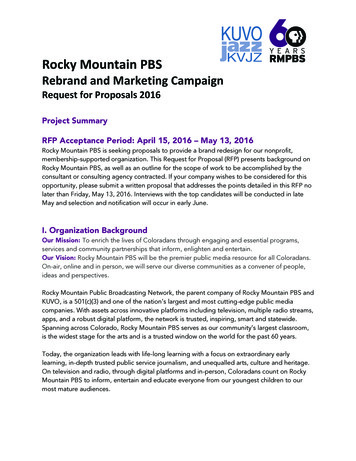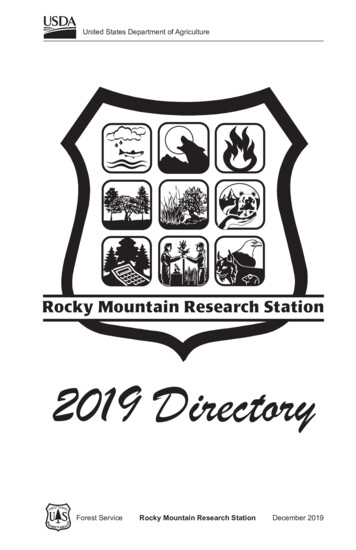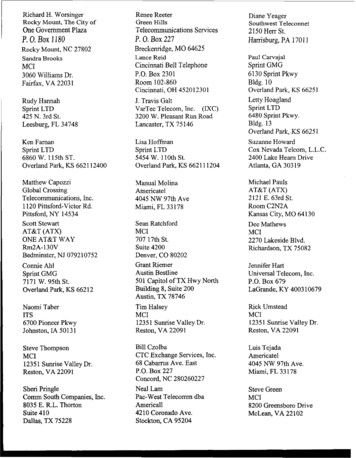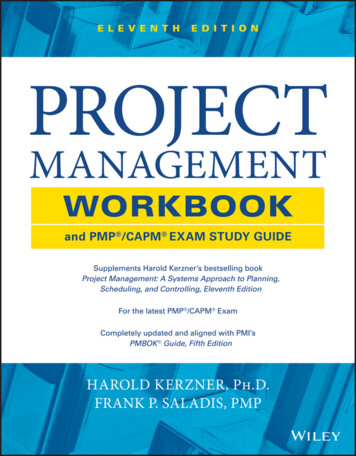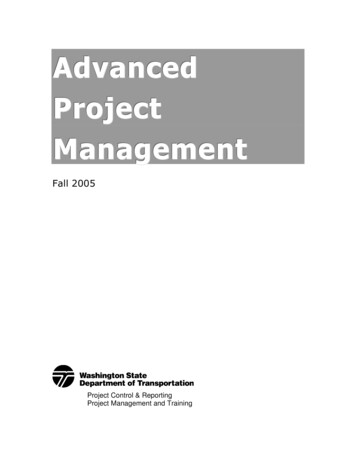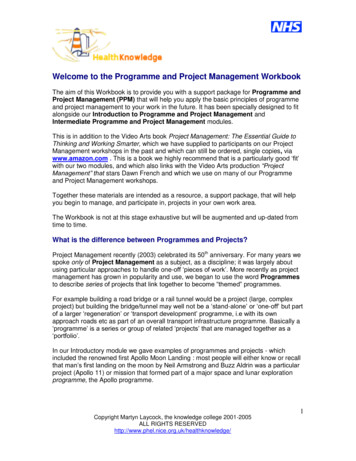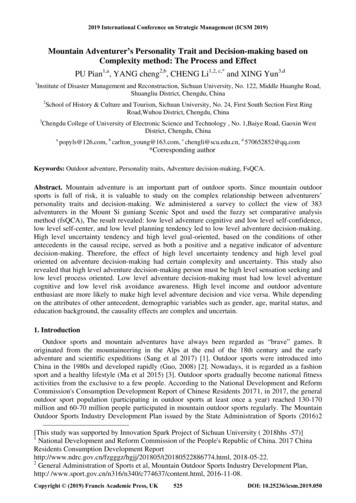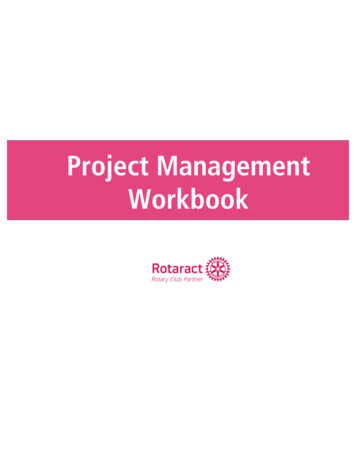
Transcription
Project ManagementWorkbook
2015 by David PosticThere is no restriction on the use of the material for the purposes oftraining or administration within Rotaract or Rotary clubs. Should thereader wish to use this material for any other purpose, please contactthe author. This copyright statement should not be removed.
ForewordThis workbook is a basic guide for project planning. It is not intended toserve as a comprehensive checklist or as a one-size-fits-all blueprint forperfect projects. It is meant simply to help the reader think through all ofthe details and contingencies that go along with planning any project.Quite often, of course, there will be unexpected problems not covered inthis or any other workbook. Therefore, it is important for the reader tosupplement the advice herein with the advice and guidance of his fellowRotaractors and Rotarians. But nothing teaches as well as experience. Sogo get some, and enjoy the ride.David PosticDistrict 5770United States
1Step One: The Basics
Every projectbegins with an idea—a vision of what the finalproduct will look like. You want your project to do something, or elseyou wouldn’t be planning it. What do you want to do? In a very generalsense, what do you want it to accomplish? What would success look liketo you? Give some thought to the following questions:1. Describe your project in 1-2 sentences. (Ex: Put on a rock concert toraise money for purchasing polio vaccines.)2. What are your goals for this project? (Ex: Raise 5,000, sell 500tickets, get good publicity for the club, engage a lot of members.)3. What would failure look like? Put another way, what is the minimumacceptable outcome for this project? (Ex: Losing money.)4. What do you want to call this project? (Ex: The Polio Pow-wow.)2
3Step Two: The Specifics
Now that youknow what the final product looks like, it istime to start getting specific. What all do you need to do to make thisproject work? Who do you need to help you? What’re your constraints?How much time do you need? Address the following topics:5. List all the activities that will need to be completed in order to makethis event successful according to the criteria you listed above. (Ex:Set date and time, reserve location, identify bands.)6. Now, in the same box above, number those activities in chronologicalorder, with 1 as the first task you’ll need to do.7. Now estimate how long you think each task will take to accomplish.Keep in mind that, for some tasks, you can only go as fast as it takespeople to respond to your communications.8. Now connect related activities with lines. (Ex: Reserving a venue andpaying for that reservation.)4
Before you goany further, you will need to get some teammembers to help with the project. Using the activities you listed above,divide up the responsibilities into different categories or clusters. Forexample, you might cluster all the activities having to do with the band(identifying bands, scheduling, equipment, set-up).9. Now go through those clusters and create however many positionsyou think you need to execute this project. Keep in mind that eachposition should have enough responsibilities to keep team membersbusy and engaged, but not too busy that the job is too difficult.10. Select team members to fill those positions.5
Once you haveselected your team members and assignedthem their tasks, you need to make sure that they all have a thoroughunderstanding of what their role is and what is expected of them. Meetwith your team and brainstorm, asking questions such as:11. In your own words, describe your position. What are your duties?12. What goals do you have? What would make this a successful event?13. Aside from what you’ve already been told, are there any additionaltasks or duties that you think need to be done?14. Create a detailed timeline for completing your activities.15. Create a list of contacts you may need for fulfilling your role.16. Develop group expectations. (Ex: Respond to emails, texts, and callsin a timely manner; always be honest about your progress; ask forhelp when you need it.)Depending on the size of your event, these questions and activities might bebest discussed at some sort of retreat or meeting once you select your team.Take at least an hour or two to meet with your team (ALL of your team) forplanning and teambuilding.6
Now it’s timeto get more specific. You need to decide onthe particulars of your event (date, time, location), as well as develop atimeline for everything you need to do between now and the date of theevent. Break everything down into its smallest task and be conservativein your estimates of how long things will take.17. What will be the date and time for the event? If this event requiresstudent participation, you should check relevant university websitesto find the best possible date and time so that the most students canattend. Also check with the board to make sure the club does not haveany other activities going on. List your top 3 dates and times below:18. Where do you want your event to be held? What is the venue?19. Now you need to create two schedules for your event. One scheduleincludes everything you need to do leading up to the event. The otherincludes everything you need to do the day of (or week of) the event.Several tips for creating these timelines: Work backwards from the event. You have already estimated howlong each activity will take, as well as the chronological order of theactivities. By working backwards from the time of the event, youcan figure out when you need to have each activity completed. Break down your schedule and decide what activities you need tohave accomplished by the end of a week. Then you can scheduletasks throughout the week to make them more manageable. Have your team members create their own schedules, based onyour master schedule. Review these schedules with them and makesure they fit with the master schedule. Most importantly of all, stick to your schedule.7
8Build your schedules below, or attach as a separate page.
9
10Step Three:The Performance
At this point,you and your team should have a thoroughunderstanding of everything that needs to be accomplished and whenyou are going to accomplish it. As a leader, though, you need to plan forthe worst.20. In the box below, list everything that could possibly go wrong withthis project. (Ex: Team member doesn’t get something done on time,you don’t reach your sponsorship goal, a band doesn’t show up, theroom you reserved suddenly isn’t available anymore, nobody showsup for the concert, tornado cancels the event.)21. Now that you have identified everything that could go wrong, youneed to plan for how you will respond to each of those problems. Eachone may affect different aspects of your project, so you should workwith each of your team members to develop your responses. Createthose Disaster Response Plans below, or attach as a separate page.11
12
You have your plan.Now, it is time for you and yourteam to execute that plan. If you’ve done everything right so far, thenyou should have: A vision of what a successful event looks like, teammembers with assigned responsibilities and goals to achieve that vision,a timeline for accomplishing those goals, a schedule for the day (orweek) of the event, and plans for every type of disaster that couldhappen. How do you use all of that to actually put on a great project?22. Throughout your planning process, schedule regular meetings withyour team, either individually or as a group, to assess their progressand the status of the event as a whole. You need to know what is doneand what isn’t, and how you (and the rest of the team) can help otherteam members complete their tasks.23. The week before your project is set to take place, go over your day-ofor week-of schedule with your team to make sure that all of youunderstand your roles and deadlines for the coming week.24. This is also a good time to incorporate other club members into yourplans. In the box below, list all the tasks that you need volunteers for.Keep in mind that these tasks should not involve high-level conceptplanning, communications with people the volunteers aren’t familiarwith, or anything that requires a substantial amount of preparation.Think manual labor, set-up, take-down, ushering, etc.13
1425. Make announcements at your club meeting to find volunteers. Alsoconsider utilizing Interact and Rotary clubs.26. As the event approaches, also remember to utilize your Board ofDirectors. For instance, if you have a social media plan designed topublicize the event, work with the PR chair to use the club’s socialmedia accounts.Finally, the day has arrived.When the date of theevent rolls around, you should be completely prepared. This is the benefit ofplanning: You should just be able to sit back and supervise everything that ishappening. Convert your day-of schedule into a checklist and make sureeverything gets checked off. It can be that easy if you plan accordingly.27. Here is the most important piece of advice I can give you for when thedate of your event arrives: Relax. Problems will arise. Things will gowrong. The event might not turn out as planned. But if you have doneeverything in this workbook, you have done everything you can. Noone can ask any more of you than that. So be alert and be prepared,but whatever happens you should be proud of yourself and your team.Make it your job to de-stress your team and to make the event as funfor them as possible.Project planning can be a very fun and rewarding experience if you do itcorrectly. Make this as good of an experience as possible for everyoneinvolved in the project. If you can do that, then your project will always besuccessful in the ways that matter most.
15Step Four:The Follow-Up
Whew!The hard part is over. You survived. And hopefully, yourproject was a smashing success. But your job isn’t quite done yet. Youstill need to tie up any loose ends and perform a few more tasks.28. First things first: Make any remaining payments that need to be madeor close out any bank accounts that need to be cleared. Your financialobligations should be covered before the event takes place, but in theevent you still have some outstanding obligations, list them below.29. Prepare a project evaluation form for you and your team members tofill out after the project is done. This is best prepared before the eventtakes place so that the evaluation can occur immediately afterward.Several considerations for crafting a useful project evaluation: Go through each task you performed in planning and executingthis project and ask: Was there something that could have madethis easier? Did anything go wrong? How did you solve the problem? If youdidn’t solve it at the time, how could you have solved it? What did you learn while planning this project? (Ex: Did you learnhow to reserve rooms in a building? Did you learn that your eventrequired security? Did you learn how to open a bank account?) What this event fun for you and your team? What could have madeit more fun?Think of any question that is relevant to the event and ask it of youand your team. Then save the results of the evaluation in your club’sfiles so that future project chairs can consult them.16
1730. Prepare a final report for the project. It doesn’t have to be long, but itshould include your evaluation of the project, both qualitative andquantitative. How many people attended? How many Rotaractorswere involved? How much money did you raise? Make it a narrativeon the successes and shortcomings of the project. Write it as thoughyou are giving the next event chair all your advice for how they canrun this event successfully. Present a summary of that report at aboard meeting and save it in your club’s files.31. Write thank-you notes to everyone involved. Thank every one of yourteam members, every secretary that helped you reserve a room, everyRotarian who offered you advice, every band who offered to play inyour concert, every sponsor who gave you money, etc. You don’t needto thank those who attended the event, but you should write a note toall the people who contributed to its success. This is simply a goodway to maintain relationships with people who you may need to workwith in the future. Plus, if you make them feel good about helpingyou, they will be more likely to help the club with the event next time.32. If you solicited sponsorship and those sponsorships require any postevent performance on your part, make sure you fulfill all of thoseobligations. For instance, some school departments require that anyorganization receiving sponsorship money must submit pictures anda summary of the event to that department. Not following through onthose requirements may preclude your club from getting sponsorshipfrom that department in the future.33. There is one final thing I recommend doing after an event: Celebratewith your team. Go out for ice cream, watch a movie, do something.You are the leader and you should lead them in feeling good abouttheir accomplishments. Make this a great experience for them.And that’s it!If you follow the steps laid out in this workbook,you should be well prepared to put on a successful event. Of course, no twoevents are the same, and there will always be different considerations fordifferent projects. In that respect, this workbook may sometimes beinadequate or even unnecessary. But the point of these guidelines is to giveyou a glimpse of what makes a successful project and to encourage you tothink critically about planning and executing your project, whatever it maybe. So go forth, be prepared, and always remember the cardinal rule ofproject planning: HAVE FUN!
Project planning can be a very fun and rewarding experience if you do it correctly. Make this as good of an experience as possible for everyone involved in the project. If you can do that, then your project will always be successful in the ways that matter most. Finally, the day has arrived. When the date of the
